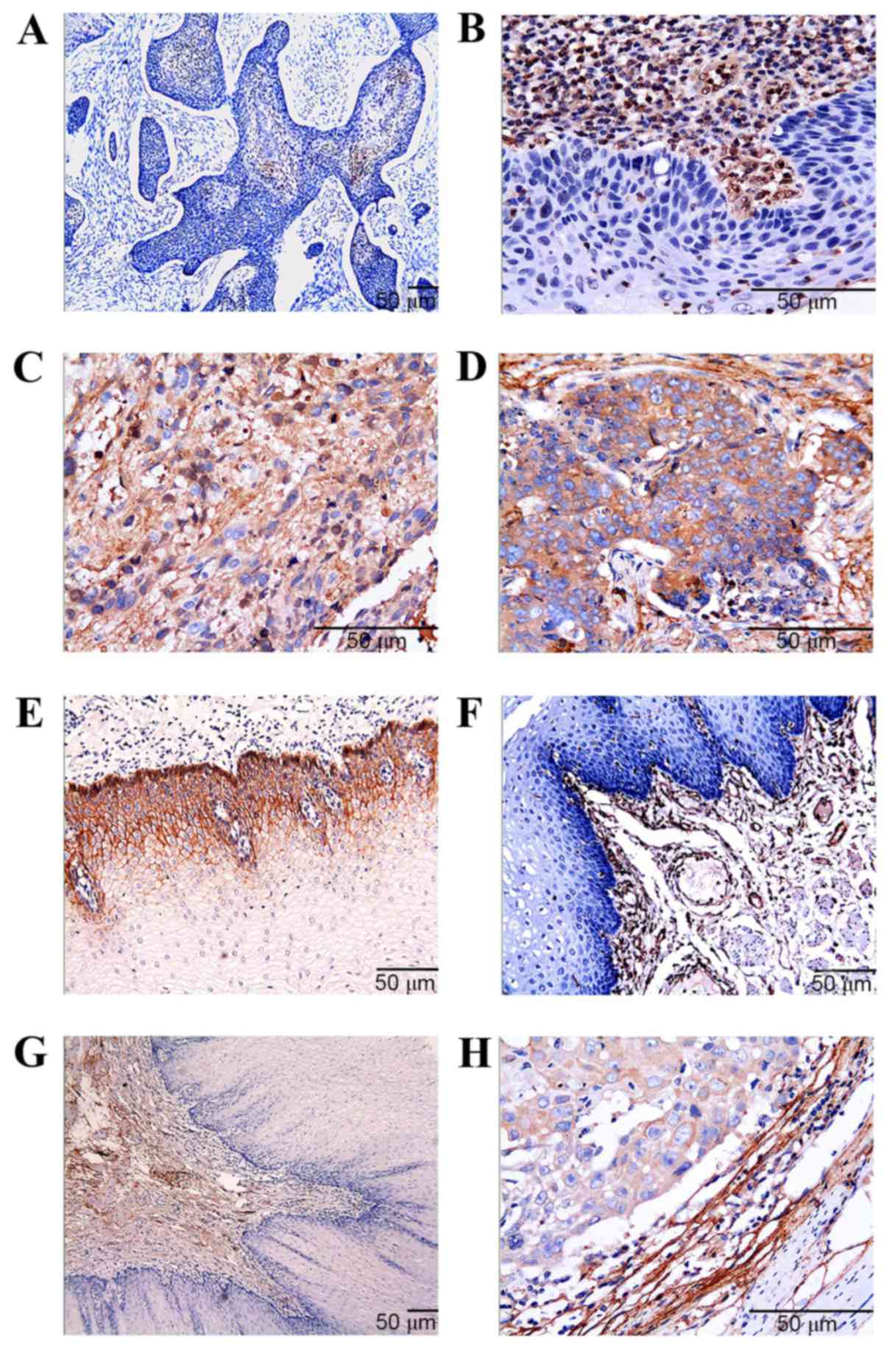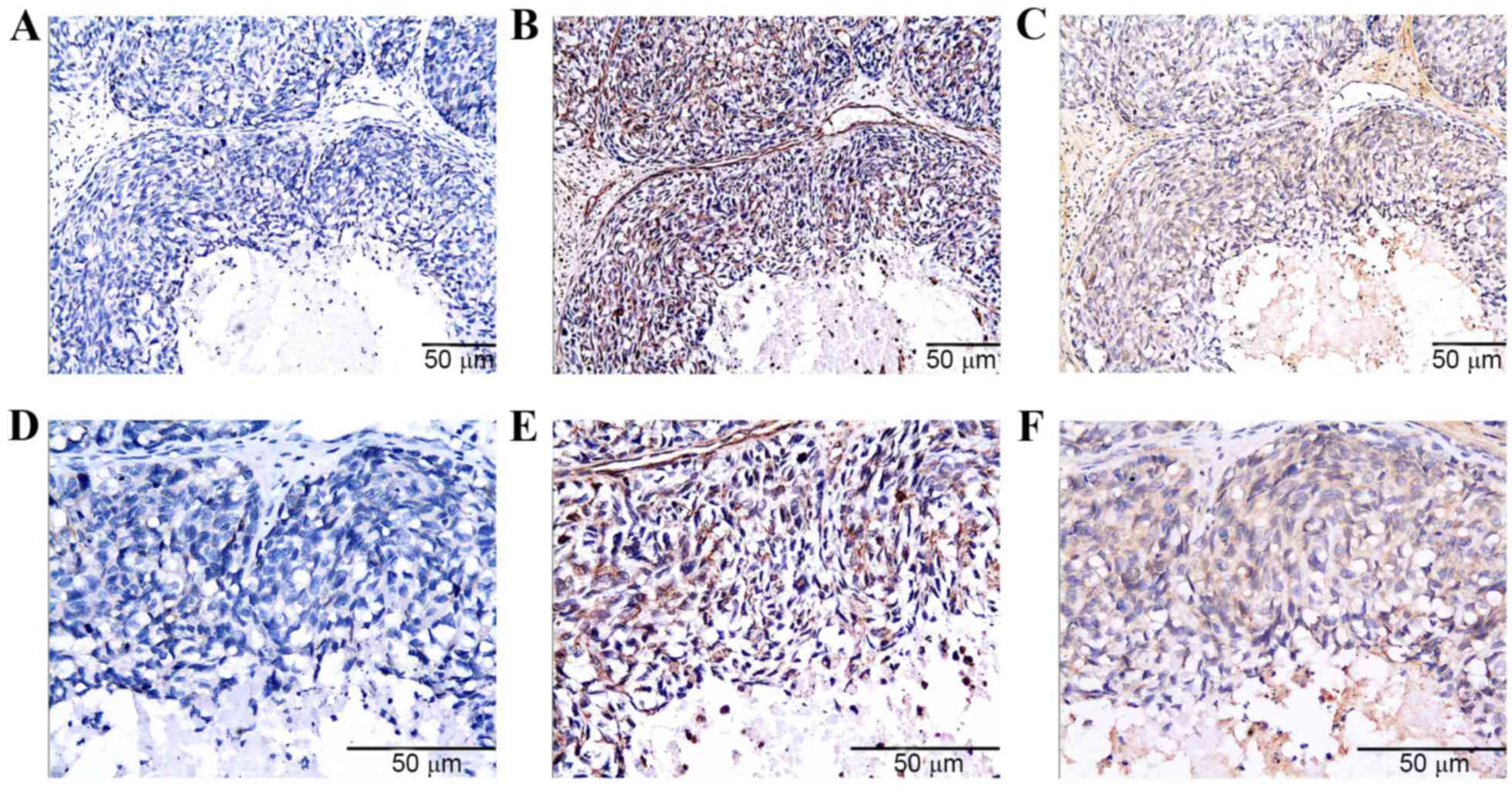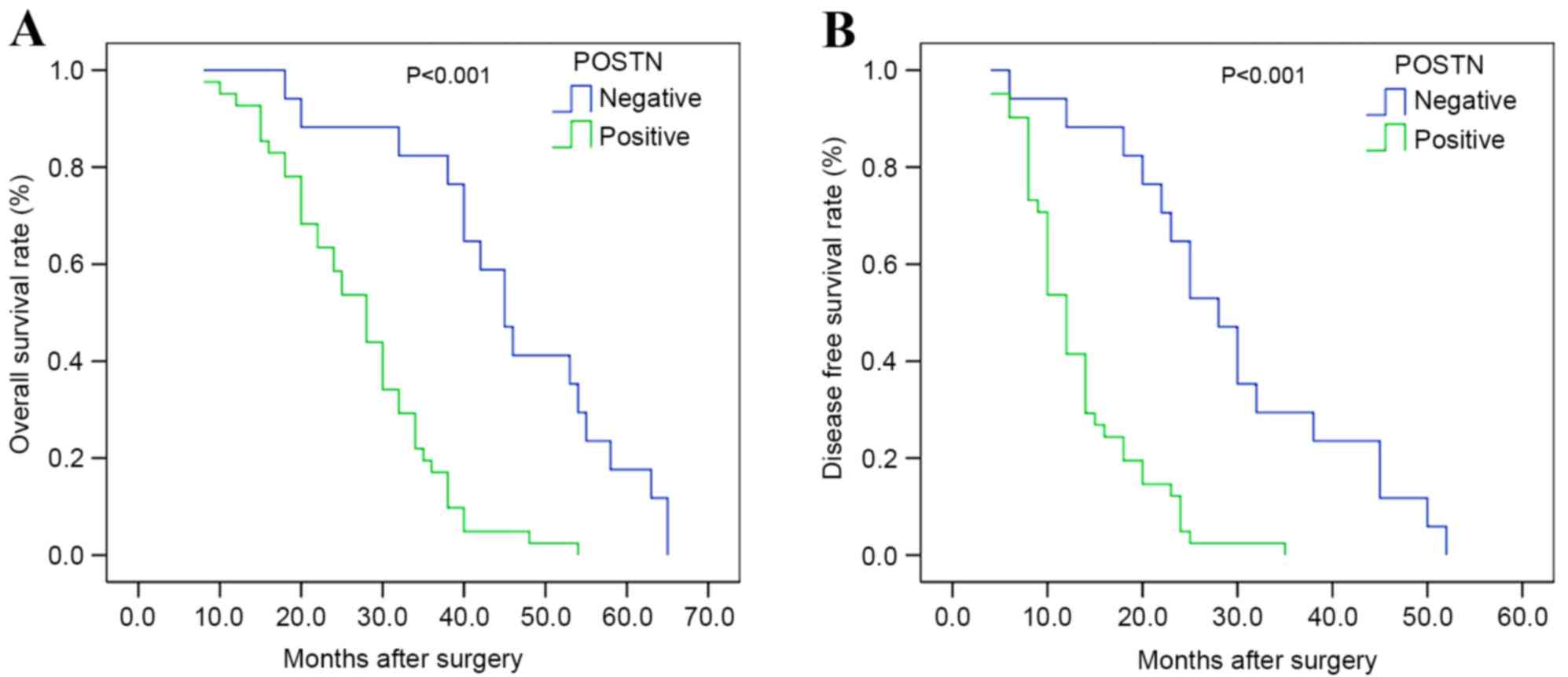|
1
|
Lin Y, Totsuka Y, He Y, Kikuchi S, Qiao Y,
Ueda J, Wei W, Inoue M and Tanaka H: Epidemiology of esophageal
cancer in Japan and China. J Epidemiol. 23:233–242. 2013.
View Article : Google Scholar : PubMed/NCBI
|
|
2
|
Tu CC, Hsu PK, Chien LI, Liu WC, Huang CS,
Hsieh CC, Hsu HS and Wu YC: Prognostic histological factors in
patients with esophageal squamous cell carcinoma after preoperative
chemoradiation followed by surgery. BMC Cancer. 17:622017.
View Article : Google Scholar : PubMed/NCBI
|
|
3
|
Marcucci F, Stassi G and De Maria R:
Epithelial-mesenchymal transition: A new target in anticancer drug
discovery. Nat Rev Drug Discov. 15:311–325. 2016. View Article : Google Scholar : PubMed/NCBI
|
|
4
|
Miyoshi A, Kitajima Y, Sumi K, Sato K,
Hagiwara A, Koga Y and Miyazaki K: Snail and SIP1 increase cancer
invasion by upregulating MMP family in hepatocellular carcinoma
cells. Br J Cancer. 90:1265–1273. 2014. View Article : Google Scholar
|
|
5
|
Jang SY, Park SY, Lee HW, Choi YK, Park
KG, Yoon GS, Tak WY, Kweon YO, Hur K and Lee WK: The combination of
periostin overexpression and microvascular invasion is related to a
poor prognosis for hepatocellular carcinoma. Gut Liver. 10:948–954.
2016. View
Article : Google Scholar : PubMed/NCBI
|
|
6
|
Vardaki I, Ceder S, Rutishauser D,
Baltatzis G, Foukakis T and Panaretakis T: Periostin is identified
as a putative metastatic marker in breast cancer-derived exosomes.
Oncotarget. 7:74966–74978. 2016.PubMed/NCBI
|
|
7
|
Molena D, Mungo B, Stem M, Poupore AK,
Chen SY and Lidor AO: Does quality of care matter? A study of
adherence to national comprehensive cancer network guidelines for
patients with locally advanced esophageal cancer. J Gastrointest
Surg. 19:1739–1747. 2015. View Article : Google Scholar : PubMed/NCBI
|
|
8
|
Jiang Y, Liao L, Shrestha C, Ji S, Chen Y,
Peng J, Wang L, Liao E and Xie Z: Reduced expression of E-cadherin
and p120-catenin and elevated expression of PLC-γ1 and PIKE are
associated with aggressiveness of oral squamous cell carcinoma. Int
J Clin Exp Pathol. 8:9042–9051. 2015.PubMed/NCBI
|
|
9
|
Lanier MH, Kim T and Cooper JA: CARMIL2 is
a novel molecular connection between vimentin and actin essential
for cell migration and invadopodia formation. Mol Biol Cell.
26:4577–4588. 2015. View Article : Google Scholar : PubMed/NCBI
|
|
10
|
Paccione RJ, Miyazaki H, Patel V, Waseem
A, Gutkind JS, Zehner ZE and Yeudall WA: Keratin down-regulation in
vimentin-positive cancer cells is reversible by vimentin RNA
interference, which inhibits growth and motility. Mol Cancer Ther.
7:2894–2903. 2008. View Article : Google Scholar : PubMed/NCBI
|
|
11
|
Bayo P, Jou A, Stenzinger A, Shao C, Gross
M, Jensen A, Grabe N, Mende CH, Rados PV, Debus J, et al: Loss of
SOX2 expression induces cell motility via vimentin up-regulation
and is an unfavorable risk factor for survival of head and neck
squamous cell carcinoma. Mol Oncol. 9:1704–1719. 2015. View Article : Google Scholar : PubMed/NCBI
|
|
12
|
Jin MS, Hyun CL, Park IA, Kim JY, Chung
YR, Im SA, Lee KH, Moon HG and Ryu HS: SIRT1 induces tumor invasion
by targeting epithelial mesenchymal transition-related pathway and
is a prognostic marker in triple negative breast cancer. Tumour
Biol. 37:4743–4753. 2016. View Article : Google Scholar : PubMed/NCBI
|
|
13
|
Yan TT, Fu XL, Li J, Bian YN, Liu DJ, Hua
R, Ren LL, Li CT, Sun YW, Chen HY, et al: Downregulation of RPL15
may predict poor survival and associate with tumor progression in
pancreatic ductal adenocarcinoma. Oncotarget. 6:37028–37042.
2015.PubMed/NCBI
|
|
14
|
Hu Q, Tong S, Zhao X, Ding W, Gou Y, Xu K,
Sun C and Xia G: Periostin mediates TGF-β-induced epithelial
mesenchymal transition in prostate cancer cells. Cell Physiol
Biochem. 36:799–809. 2015. View Article : Google Scholar : PubMed/NCBI
|
|
15
|
Litvin J, Selim AH, Montgomery MO, Lehmann
K, Rico MC, Devlin H, Bednarik DP and Safadi FF: Expression and
function of periostin-isoforms in bone. J Cell Biochem.
92:1044–1061. 2004. View Article : Google Scholar : PubMed/NCBI
|
|
16
|
Contié S, Voorzanger-Rousselot N, Litvin
J, Clézardin P and Garnero P: Increased expression and serum levels
of the stromal cell-secreted protein periostin in breast cancer
bone metastases. Int J Cancer. 128:352–360. 2011. View Article : Google Scholar : PubMed/NCBI
|
|
17
|
Wang W, Sun QK, He YF, Ma DC, Xie MR, Ji
CS and Hu B: Overexpression of periostin is significantly
correlated to the tumor angiogenesis and poor prognosis in patients
with esophageal squamous cell carcinoma. Int J Clin Exp Pathol.
7:593–601. 2014.PubMed/NCBI
|
|
18
|
Underwood TJ, Hayden AL, Derouet M, Garcia
E, Noble F, White MJ, Thirdborough S, Mead A, Clemons N, Mellone M,
et al: Cancer-associated fibroblasts predict poor outcome and
promote periostin-dependent invasion in oesophageal adenocarcinoma.
J Pathol. 235:466–477. 2015. View Article : Google Scholar : PubMed/NCBI
|
|
19
|
Li S, Qin X, Li Y, Zhang X, Niu R, Zhang
H, Cui A, An W and Wang X: MiR-133a suppresses the migration and
invasion of esophageal cancer cells by targeting the EMT regulator
SOX4. Am J Transl Res. 7:1390–1403. 2015.PubMed/NCBI
|
|
20
|
Sato F, Kubota Y, Natsuizaka M, Maehara O,
Hatanaka Y, Marukawa K, Terashita K, Suda G, Ohnishi S, Shimizu Y,
et al: EGFR inhibitors prevent induction of cancer stem-like cells
in esophageal squamous cell carcinoma by suppressing
epithelial-mesenchymal transition. Cancer Biol Ther. 16:933–940.
2015. View Article : Google Scholar : PubMed/NCBI
|
|
21
|
Wu SQ, Lv YE, Lin BH, Luo LM, Lv SL, Bi AH
and Jia YS: Silencing of periostin inhibits nicotine-mediated tumor
cell growth and epithelial-mesenchymal transition in lung cancer
cells. Mol Med Rep. 7:875–880. 2013.PubMed/NCBI
|
|
22
|
Liu Y and Liu BA: Enhanced proliferation,
invasion, and epithelial-mesenchymal transition of
nicotine-promoted gastric cancer by periostin. World J
Gastroenterol. 17:2674–2680. 2011. View Article : Google Scholar : PubMed/NCBI
|
|
23
|
Kanno A, Satoh K, Masamune A, Hirota M,
Kimura K, Umino J, Hamada S, Satoh A, Egawa S, Motoi F, et al:
Periostin, secreted from stromal cells, has biphasic effect on cell
migration and correlates with the epithelial to mesenchymal
transition of human pancreatic cancer cells. Int J Cancer.
122:2707–2718. 2008. View Article : Google Scholar : PubMed/NCBI
|
|
24
|
Kim CJ, Sakamoto K, Tambe Y and Inoue H:
Opposite regulation of epithelial-to-mesenchymal transition and
cell invasiveness by periostin between prostate and bladder cancer
cells. Int J Oncol. 38:1759–1766. 2011.PubMed/NCBI
|
|
25
|
Soltermann A, Tischler V, Arbogast S,
Braun J, Probst-Hensch N, Weder W, Moch H and Kristiansen G:
Prognostic significance of epithelial-mesenchymal and
mesenchymal-epithelial transition protein expression in non-small
cell lung cancer. Clin Cancer Res. 14:7430–7437. 2008. View Article : Google Scholar : PubMed/NCBI
|
|
26
|
Gillan L, Matei D, Fishman DA, Gerbin CS,
Karlan BY and Chang DD: Periostin secreted by epithelial ovarian
carcinoma is a ligand for alpha (V)beta(3) and alpha(V)beta(5)
integrins and promotes cell motility. Cancer Res. 62:5358–5364.
2002.PubMed/NCBI
|
|
27
|
Bao S, Ouyang G, Bai X, Huang Z, Ma C, Liu
M, Shao R, Anderson RM, Rich JN and Wang XF: Periostin potently
promotes metastatic growth of colon cancer by augmenting cell
survival via the Akt/PKB pathway. Cancer Cell. 5:329–339. 2004.
View Article : Google Scholar : PubMed/NCBI
|
|
28
|
Mosher DF, Johansson MW, Gillis ME and
Annis DS: Periostin and TGF-β-induced protein: Two peas in a pod?
Crit Rev Biochem Mol Biol. 50:427–439. 2015.PubMed/NCBI
|
|
29
|
Heidari P, Esfahani SA, Turker NS, Wong G,
Wang TC, Rustgi AK and Mahmood U: Imaging of secreted extracellular
periostin, an important marker of invasion in the tumor
microenvironment in esophageal cancer. J Nucl Med. 56:1246–1251.
2015. View Article : Google Scholar : PubMed/NCBI
|
|
30
|
Wong GS, Lee JS, Park YY, Klein-Szanto AJ,
Waldron TJ, Cukierman E, Herlyn M, Gimotty P, Nakagawa H and Rustgi
AK: Periostin cooperates with mutant p53 to mediate invasion
through the induction of STAT1 signaling in the esophageal tumor
microenvironment. Oncogenesis. 2:e592013. View Article : Google Scholar : PubMed/NCBI
|
|
31
|
Hong LZ, Wei XW, Chen JF and Shi Y:
Overexpression of periostin predicts poor prognosis in non-small
cell lung cancer. Oncol Lett. 6:1595–1603. 2013.PubMed/NCBI
|
|
32
|
Nuzzo PV, Rubagotti A, Argellati F, Di
Meglio A, Zanardi E, Zinoli L, Comite P, Mussap M and Boccardo F:
Prognostic value of preoperative serum levels of periostin (PN) in
early breast cancer (BCa). Int J Mol Sci. 16:17181–17192. 2015.
View Article : Google Scholar : PubMed/NCBI
|
|
33
|
Li Z, Zhang X, Yang Y, Yang S, Dong Z, Du
L, Wang L and Wang C: Periostin expression and its prognostic value
for colorectal cancer. Int J Mol Sci. 16:12108–12118. 2015.
View Article : Google Scholar : PubMed/NCBI
|
|
34
|
Nuzzo PV, Rubagotti A, Zinoli L, Ricci F,
Salvi S, Boccardo S and Boccardo F: Prognostic value of stromal and
epithelial periostin expression in human prostate cancer:
Correlation with clinical pathological features and the risk of
biochemical relapse or death. BMC Cancer. 12:6252012. View Article : Google Scholar : PubMed/NCBI
|
|
35
|
Ryner L, Guan Y, Firestein R, Xiao Y, Choi
Y, Rabe C, Lu S, Fuentes E, Huw LY, Lackner MR, et al: Upregulation
of periostin and reactive stroma is associated with primary
chemoresistance and predicts clinical outcomes in epithelial
ovarian cancer. Clin Cancer Res. 21:2941–2951. 2015. View Article : Google Scholar : PubMed/NCBI
|

















